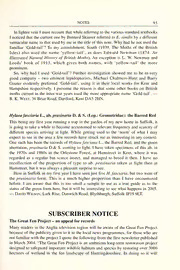
Hylaea fasciaria L., ab. prasinaria D. & S. (Lep.: Geometridae): the barred red PDF
Preview Hylaea fasciaria L., ab. prasinaria D. & S. (Lep.: Geometridae): the barred red
NOTES 93 In lightervein I mustrecount tliatwhile referring tothe various standard textbooks I noticed that the current one by Bernard Skinnerreferred to E. similis by a different vernacularname to that used by me in the title ofthis note. Why had he not used the familiar 'Gold-tail'? To my astonishment. South (1939. The Moths of the British Isles) also used the name 'yellow-tail', as does Edward Newman (1874. An Illustrated Natural History ofBritish Moths). An exception is L. W. Newman and Leeds' book of 1913, which gives both names, with 'yellow-tail' the more prominent. So, why had I used 'Gold-tail'? Further investigation showed me to be in-very good company - two eminent lepidopterists, Michael Chalmers-Hunt and Barry Goater evidently preferred 'Gold-tail', using it in their local works for Kent and Hampshire respectively. I presume the reason is that some other books on Briti—sh moths current in the inter-war years used the more appropriate name 'Gold-tail'. B. K. West, 36 BriarRoad, Dartford, Kent DAS 2HN. Hylaeafasciaria L.,ah.prasinaria D. & S. (Lep.: Geometridae): the Barred Red This being my first year running a trap in the garden ofmy new home in Suffolk, it is going to take a while to become accustomed to relevant frequency and scarcity of different species arriving at light. While getting used to the 'norm' of what I may expect to see in the area a few records have struck me as interesting in any context. One such has been the records ofHylaeafasciana L., the Barred Red, and the green aberration,prasinaria D.& S. coming to light. I have taken specimens ofthis ab. in the 1970s and 1980s in the Orlestone Forest, at Hamstreet in Kent, where it was regarded as a regular but scarce insect, and managed to breed it then. I have no recollection of the proportion of type to ab. prasinaria taken at light then at Hamstreet, butitwas always apleasant surprise to see. Here in Suffolk in my first year I have seenjust five H.fasciaria, but two were of the prasinaria form. This is a much higher proportion than I have encountered before. I am aware that this is too small a sample to use as a true guide as to the —status ofthe green form here, but it will be interesting to see what happens in 2005. DavidWilson, Lark Rise, Dunwich Road, Blythburgh, SuffolkIP19 9LT. SUBSCRIBER NOTICE TheGreatFenProject-anappealforrecords Many readers in the Anglia television region will be aware ofthe Great Fen Project because ofthe publicity given to it in the local news programmes, for those who are notfamiliarwith the project I quote the following from the first newsletterpublished in March 2004. "The Great Fen Project is an ambitious long-term restoration project designed to safeguard important wildlife habitats and species by restoring over 3000 hectares of wetland in the fen landscape of Huntingdonshire. In doing so it will
